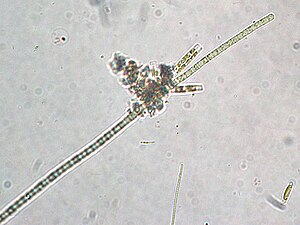Green Spanalga
| Green Spanalga | ||||||||||||
|---|---|---|---|---|---|---|---|---|---|---|---|---|

Green Spanalga |
||||||||||||
| Systematics | ||||||||||||
|
||||||||||||
| Scientific name | ||||||||||||
| Aphanizomenon flos-aquae | ||||||||||||
| ( Linnaeus ) Ralfs ex Bornet & Flahault |
The green span alga ( Aphanizomenon flos-aquae ), also known as AFA alga or "blue-green alga", is a cyanobacteria ("blue-green algae") species known as water bloom (lat. Flos aquae = "bloom of water") in Lakes and ponds occurs. Cyanobacteria expelled as food supplements are mainly harvested in Lake Klamath in southern Oregon (USA).
Dietary Supplements and Alternative Medicine
The bacteria are widely traded as dietary supplements. Common trade names for the bacterial preparations, which are mostly sold in powder or tablet form, are “Uralgae”, “AFA Algae”, “Blue Green” or “Bluegreen” in English. Manufacturers and sellers of such preparations attribute them to a positive effect on general well-being, a healthy nervous system and optimal brain function. However, the Federal Institute for Consumer Health Protection and Veterinary Medicine is very critical of the claim of a medical effect. The MD Anderson Cancer Center at the University of Texas also classifies the scientific evidence for alleged medical effects as "unclear" .
The AFA bacteria supply 20 (of the 25 known in the human body) amino acids , including the eight essential amino acids . In addition, the cyanobacterium has enzymes and vitamins , minerals and trace elements that, as coenzymes, are part of enzymes. AFA contains beta carotene ( provitamin A), most B vitamins and vitamin E . In addition, the AFA bacteria have more essential fatty acids than seeds, nuts and algae , relative to the total substance . For example, they contain almost as much gamma-linolenic acid (GLA) as breast milk. It is also advertised with a high content of glutamic acid , the salts of which are used as flavor enhancers in numerous foods. However, the amount of nutrients ingested with normal doses of bacteria displaced as food supplements is small in absolute terms compared to that from ordinary foods.
Aphanizomenon flos-aquae is not approved as a medicinal product and consequently may not be advertised with alleged healing effects. As a result of the appearance of corresponding advertising and literature, the Federal Institute for Consumer Health Protection and Veterinary Medicine and the Federal Institute for Drugs and Medical Devices warned in 2002 against the use of bacteria as "alternative remedies", among others for attention deficit / hyperactivity disorder (ADHD), and especially there with children.
Toxicity
Some strains of Aphanizomenon flos-aquae produce anatoxins , poisons that either directly cause permanent stimulation of the acetylcholine receptors in the nerve cells or inhibit the enzyme acetylcholinesterase and are thus comparable in their effects to nerve gases such as sarin and tabun . Furthermore, Aphanizomenon flos-aquae strains found in Germany produce the toxins Cylindrospermopsin and Saxitoxin . These toxins can be life-threatening to animals when drinking contaminated water or swimming in contaminated water. In a study of sixteen products sold as food supplements, the University of Konstanz found in ten cases alarmingly high amounts of microcystin , a strong liver toxin.
Environmental and health hazards from mass blooms
The massive occurrence of Aphanizomenon flos-aquae and other cyanobacteria, especially as a result of over-fertilization of the waters during prolonged periods of heat and drought, has repeatedly led to concentrations of cyanobacterial toxins that are dangerous for humans and animals and prompted scientists and authorities to warn of so-called algal blooms .
Aasee, Münster, Germany, summer 2001
In the summer of 2001 there were massive blue algae blooms and high poison concentrations in the Aasee in Münster, some of which were caused by Aphanizomenon flos-aquae. In a study by the laboratory for water analysis of the Institute for Hygiene of the University Hospital Münster, the bacterial masses were observed and their toxins quantified. AFA was involved in this along with other cyanobacteria such as Microcystis aeruginosa. At the end of August, the lake overturned, with the use of the available oxygen, the formation of digester gas and the death of fish. Most of the water samples from this period revealed health risks from cyanotoxins; in places, e.g. B. in alluvial deposits on banks, was written of "very high health risk", with concentrations of an average of 13448 micrograms microcystin per liter of water.
Upper Klamath Lake, USA, summer 2015
In July 2015, the Oregon State Department of Health issued a health warning covering almost all of Upper Klamath Lake , which is where most of the AFA supplements sold as dietary supplements come. It was advised not to bathe in the water and to avoid inhaling splash water, for example from motor boats. Parts of the body and organs in which the cyanobacteria toxins are particularly concentrated should be removed from fish from the lake. At the end of the month the warning was extended to include rivers fed by Upper Klamath Lake.
Web links
- Statement by the Federal Institute for Consumer Health Protection and Veterinary Medicine of September 23, 2001 (PDF file; 21 kB)
- BgVV and BfArM warn (March 2002): Food supplements made from AFA algae cannot replace medical therapy
- Dipl. Oec. troph. Kathi Dittrich, Association for Independent Health Advice: AFA-Algae: The Blue Wonder?
- IFM GEOMAR Leibniz Institute for Marine Sciences at the University of Kiel: Poisonous cyanobacteria in the Baltic Sea
- Information system CliniTox, Switzerland, on various cyanobacteria and their toxins
- Bavarian State Office for the Environment: Toxin-forming cyanobacteria (blue-green algae) in Bavarian waters
- University of Texas
- Press release from the University of Konstanz on January 15, 2008
- City of Münster: Toxins of the cyanobacteria in the Aasee
- KTVZ: Algae Health Warning for Upper Klamath and Agency Lake
- Oregon Health Department warning extended to areas downstream